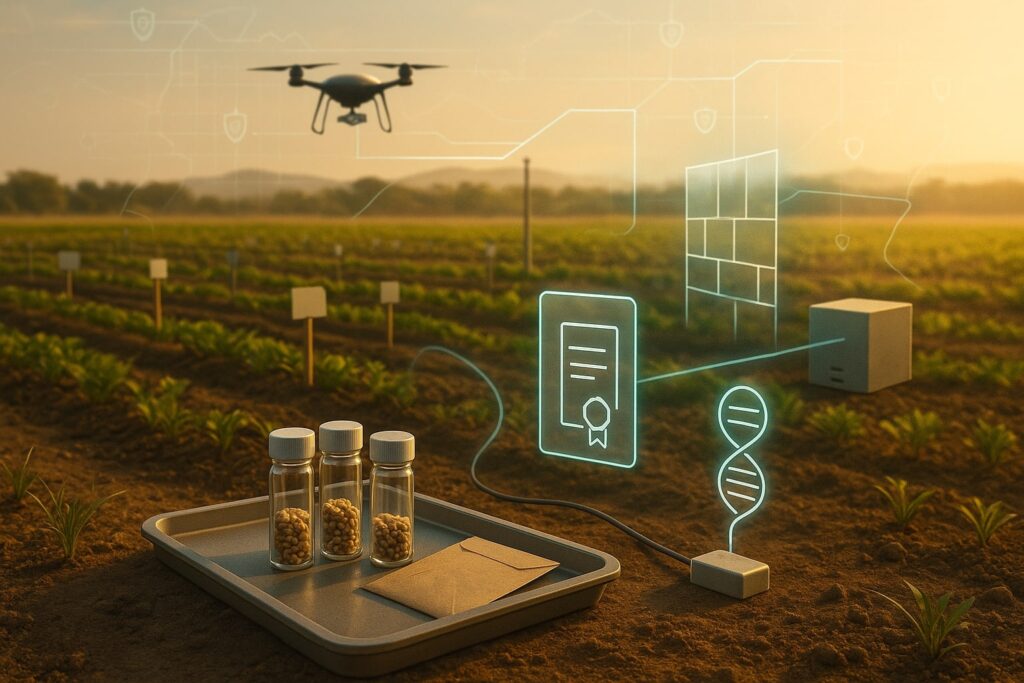China’s spy agency has singled out grain data and parent seeds as targets for foreign espionage. For investors and founders, the edge now lies in securing field-trial data, hardening on-farm devices, and proving chain-of-custody for germplasm—before regulation makes it mandatory.
Table of Contents
ToggleWhat just happened—and why it matters
On November 3, 2025 (PT), China’s Ministry of State Security (MSS) warned that foreign intelligence services are seeking to obtain grain data and seed resources, citing recent cases that included smuggling of restricted hybrid “parent seeds” and covert field surveys by foreign personnel. The message: food security is national security—and digital agronomy is part of the battlefield.
The emphasis on parent seeds is not semantics. In hybrid systems, parent lines are the crown jewels: they allow years of breeding to be replicated, and they underpin pricing power. Chinese state media framed them as “key agricultural resources” whose export is strictly prohibited—language that signals tighter border and data controls around germplasm, trial plots, and the analytics that make these assets valuable.
This comes as Beijing expands both biotech adoption and data governance. Regulators have accelerated GM and gene-edited crop approvals and are rolling out a 2024–2028 smart-ag plan to put sensors, AI and big data into fields—dramatically increasing the attack surface for theft or tampering.
The new perimeter: field trials, phenotyping streams, and cloud workflows
Field trials have gone digital. High-throughput and remote phenotyping now stream trait data, imagery and management logs from plot to cloud. These datasets are as sensitive as the seeds themselves because they reveal which traits work where, with what inputs—insight that shortens breeding cycles and informs pricing. Academic reviews and practice papers underscore how closely remote sensing and phenotyping are now intertwined with breeding decisions, not just agronomy.
Edge devices are soft targets. Ag equipment and farm platforms have had well-documented security issues—from right-to-repair jailbreaks to platform-level vulnerabilities—exactly the kind of footholds an attacker would use to siphon trial data or manipulate protocols. Even as OEMs invest in coordinated disclosure and bug-bounties, risk remains concentrated where plots meet connected machines.
Data law meets agronomy. China’s 2023 Counter-Espionage Law broadened “espionage” to include data, materials and items tied to national security, with overlapping regimes under the Data Security Law and new “important data” standards. In practice, this means trial data, location-rich imagery, and supply-chain documentation can all trigger controls—especially if a sectoral catalogue deems them sensitive.
The market signal: scarcity value is shifting from traits to telemetry
- Imports show dependency—and sensitivity. China imported $478 million of planting seeds in 2022/23, with the United States as the largest supplier. Vegetable seed imports have been volatile and, at times, sharply down—points authorities cite when arguing that control over seed sources and data is a strategic priority.
- Biotech ramp-up raises the stakes. GM corn area is set to expand, but patchy trial performance and state oversight make trial-level evidence the arbiter of adoption. Whoever controls, verifies, and secures those evidence streams controls value.
- Digital agriculture multiplies data exhaust. Beijing’s plan to build a national ag-data backbone by 2028 will improve yields—and, by design, centralise flows of field and supply-chain data that are now explicitly in scope for national-security laws.
Missed angle: Chain-of-custody for germplasm will look more like export control
Investors should read the MSS note alongside China’s recent rare earths export-control expansion, which extended to goods made outside China that contain Chinese-origin materials. If a similar logic is applied to seeds and their data—parent lines, derived trial datasets, or even model weights trained on them—expect extraterritorial compliance questions for multinationals running global breeding programs.
There’s precedent for hard enforcement: the 2016 U.S. case against Mo Hailong for stealing inbred corn seed laid bare how valuable (and portable) elite lines are—and why both sides now treat them as strategic. Today’s warning simply moves the front line from fields and suitcases to servers and sensors.

What this means for startups and corporates (near-term playbook)
1) Treat trial data like regulated assets.
Map phenotyping, scouting, and weather joins as if you were drafting an “important data” catalogue. Snapshot where data is generated, processed, stored and exported. If any leg crosses a border, prepare for security assessments and contractual controls consistent with China’s cross-border data FAQs.
2) Move from perimeter security to provable security.
- Hardening: lock down telemetry endpoints on tractors, drones and plot sensors; require signed firmware and MFA on cloud consoles; rotate keys per field-season; and disable default remote access on trial kits.
- Assurance: adopt continuous vulnerability disclosure programs with bounty scope that explicitly covers ag-IoT and field apps. (Large OEMs are already paying for this.)
3) Keep models close to the data.
Use federated learning and privacy-preserving analytics so trial data stays in-country while models update. This reduces export-assessment triggers and speeds collaboration with local partners.
4) Build chain-of-custody for germplasm and traits.
Pair physical seed custody logs with rapid DNA barcoding at plot ingress/egress to confirm line identity and detect contamination. Portable sequencers and low-cost barcode workflows are mature enough for field use and can be audited.
5) De-risk foreign fieldwork.
If staff, consultants, or diplomats conduct surveys, ensure permits cover mapping, imaging, and sample collection—and that routes, devices, and backups won’t look like tradecraft. (The MSS cited evasive field-survey tactics in one case; don’t give anyone that storyline.)
Compliance map: the three “gates” to clear in China
- Counter-Espionage gate – avoid activities that could be construed as collecting “documents, data, materials, and items related to national security and interests.” Build a red-flag matrix for agronomic data types (yield maps, reserve estimates, parent line descriptors).
- Data gate – classify and grade ag data (core/important/general); for potential “important data,” prepare identification memos and an outbound-transfer plan before any cross-border sync.
- Seeds/biotech gate – track evolving seed, PVP and biotech approvals; assume higher scrutiny around parent lines and trait-performance data as GM/GE adoption expands.
Investor lens: where value accrues next
- Secure-phenotyping stacks (sensors → edge → vault) that bundle compliance artifacts with data pipelines.
- Field-hardened MLOps for ag, with built-in federated training and lineage tracking for models trained on trial data.
- Germplasm authentication—fast, auditable DNA mini-barcoding kits and services that plug into breeder SOPs.
- Ag-IoT security—device identity, signed firmware, zero-trust gateways for tractors, drones and sprayers; credible bug-bounty partners.
The bottom line
China’s warning reframes seeds and farm telemetry as strategic assets. If you run trials in China—or depend on Chinese genetics and data—assume the next competitive moat will be provable custody and compliant compute, not just elite germplasm or trait IP. Move early: the firms that can show secure evidence of performance will keep collaborating—and keep selling—when the legal perimeter moves again.





